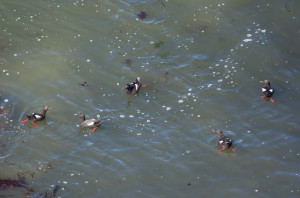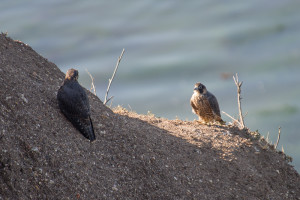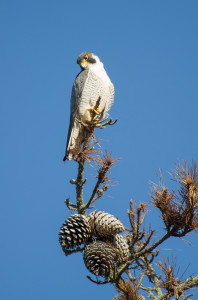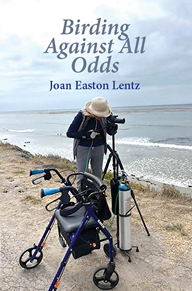Yesterday I drove to Morro Bay. It was typical spring weather, with a strong northwest wind blowing cloud shadows over the morros. These hills, which form a series of rocky outcrops beginning with Morro Rock and ending near San Luis Obispo, are really ancient “plugged” volcanoes that used to be much higher. They formed a stunning backdrop to the Los Osos Valley as I made my way towards the town of Morro Bay.
That evening, I gave a presentation to Morro Coast Audubon Society at the beautiful new auditorium near the Botanic Garden. I came away feeling that the whole Morro Bay Area has a high interest in natural history; they were an enthusiastic audience and I even sold some books.
But the fun began this morning, when I awoke to see the sun shining on Morro Rock.
This enormous crag is always attractive to nesting seabirds. As I gaze up at the ledges, I count a few Pelagic Cormorants, lots and lots of Brandt’s Cormorants — they seem to prefer the adjoining rock out to the northwest, however — and numerous Western Gulls. The shrill cries of the gulls dominate. The rock is a hive of birds busily carrying nesting material and defending territories.
My goal, of course, is to see the legendary Peregrine Falcons that have nested here for decades.
I walk around the south side of the rock. Behind me in the channel leading into the harbor, 5 or 6 Southern Sea Otters, one with a fluffy juvenile floating beside it, frolic in the morning sun. What a thrill.

Southern Sea Otters
I get to the place where the pavement ends, all the while scanning the giant rock for peregrines. There were so many birds coming and going! And I’d left my scope back in the car.
At last I see another birder with a scope, and together we examine the cliff face.
Yay! There it is! High, high up.
A juvenile peregrine just happens to walk to the edge of the cave-like opening that’s been its eerie this year. The bird looks pretty well-feathered, but its bill is thick, its head still has some pin feathers, and the rest of its plumage is a bit rumpled.
Feathers from previous kills litter the floor of the opening, but we can’t see back into the cave.
We wait patiently, hoping the adult birds will come to feed the fledgling. Another birder appears briefly and mentions there are two juveniles in a nest on the other side of this rock.
Then, a high school group walks up, and I am able to get them on the peregrine through the scope. Wow! Kids like big birds.
Meanwhile, Stuart Wilson, photographer for my recent book, has gone with his buddies down coast to take photos at another Peregrine Falcon nest site.
This is a convenient stop on my way home, and, although I’m later in the day, I exit the 101 freeway at Price St. in Shell Beach and head north towards the parking lot past the Ventana Grill and east of the tennis courts.
For many years, another pair of peregrines has nested here (see my book Introduction to Birds of the Southern California Coast for further directions.)
Stuart got great photos when he was here, but alas, I saw no falcons in scanning with my scope from the cliffs.
However, this spot is a winner for watching the Pigeon Guillemots as they swim around in the blue water below. Their high, keening whistle means they are in full breeding mode. But guillemot nests are hidden under the rocks and in earthen crevices in the cliffs, so you can’t see them.

View down to Pigeon Guillemots at Shell Beach
You can watch the Brandt’s and Pelagic Cormorants carrying kelp to nests, and the same with more of the Western Gulls. So it’s a great birding spot and you’re just off the freeway.
Even though Morro Bay and this part of the coast are considered fall and winter birding destinations, it’s amazing what you can find on a day in May.
(All photos are by Stuart Wilson.)





